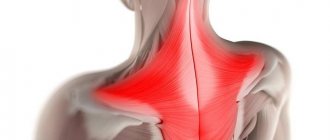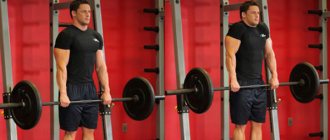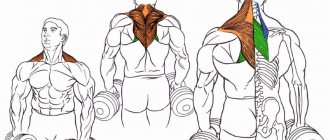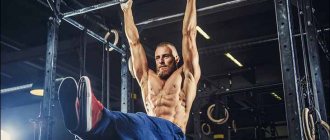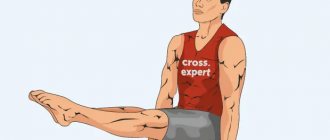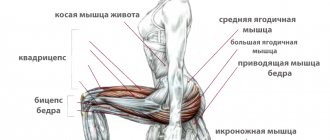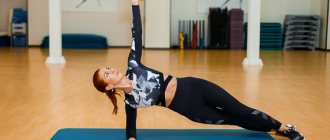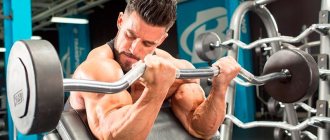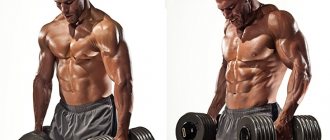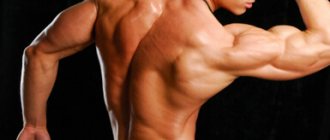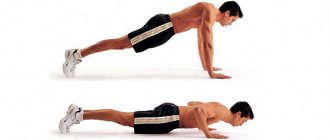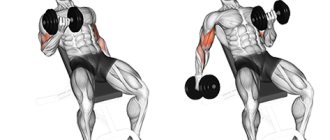Share:
What you need
- Barbell
- Dumbbells
- Exercise equipment
The shoulder girdle visually looks unfinished if the trapezius muscles are underdeveloped. In some athletes, even from a small load, the trapezius grows in proportion to the shoulders and back muscles (this option occurs in most cases). For others, the picture is completely different - even heavy specialized training gives a very modest result. In this article we will figure out how to properly train this muscle group and which trapezoid exercises are the most effective.
Anatomy of the trapezius muscles
The trapezius is located in the upper back and is adjacent to the neck muscles on top. Visually it can be divided into three parts:
- The upper one is adjacent to the neck and is responsible for raising the shoulders upward.
- The middle one is between the shoulder blades and is involved in lifting the shoulder blades.
- Lower - in the lower part of the shoulder blades, responsible for lowering the scapular bones in the lower phase of movement.
© decade3d — stock.adobe.com
The main functions of the trapezius: moving the shoulders in the vertical and horizontal plane, tilting the head back, and lifting the shoulder blades up.
Keeping trapezius in good shape is necessary for any athlete. This will increase your strength in basic exercises, reduce the load on the shoulder joints and ligaments, reduce the curvature of the spine in the cervical region and minimize the risk of damage and injury to the entire shoulder girdle.
Strap on and pull weights
Some people are convinced that straps are for weaklings and you can develop a much stronger grip without them.
“I’ve never heard a conversation begin with the words: wow, what strong hands you have! If you want to build powerful, big muscles, wear straps and lift real weights,” Capurso says.
The grip will always be your weak link when it comes to training the large and powerful muscles of the back, including the trapezius. If your grip betrays you before your traps are truly tired, you will never be able to reach their full potential. Most strong guys can do shrugs with a 200 kg barbell, and only a few are able to hold the prohibitive weight without belts for an entire set of 12 repetitions.
There is no reason to think that using wrist straps is “cheating” or that it is “uncool.” Considering that you are training to create an ideal body, you should only worry about training your muscles as intensely and effectively as possible. So wrap up your straps to hold heavy weights!
Recommendations for training the trapezius
- Shrugs are rightfully considered the best exercise for developing the trapezius, but many athletes do them incorrectly. You cannot use your biceps and forearms. Wrist straps help to cope with this very well. The elbows should be almost completely straight throughout the entire approach, then the load will be placed specifically on the trapezius.
- Don't use too much weight. When training the trapezius muscles, it is much more important to work in full amplitude and feel the maximum muscle contraction at the top point, holding it for 1-2 seconds.
- Do not tuck your chin to your chest when doing shrugs. This increases compression of the cervical spine and can lead to injury.
- Trapezius loves pumping. To properly “pump” these muscles with blood, use supersets, combining shrugs of any variation with pulling movements that also include the shoulders in the work, for example, with a close-grip chin row. Another option for increasing intensity is to perform dropsets at the end of each set: reduce the working weight and, without rest, do another set or two with a lighter weight.
- Trapezius is a relatively small muscle group; it is enough to train it once a week. It is optimal to combine it with back or shoulder training. To make the entire shoulder girdle look massive, do not forget to pay enough attention to your deltoids and neck muscles. If you notice that the trapezius has begun to overtake the shoulders in development, which visually makes the figure less wide in the shoulder girdle, just stop doing individual exercises for this muscle group.
- Trapezius training should be short but intense. As a rule, one or two exercises are enough to work this muscle group. Alternate different movements in each workout and perform them in different orders, then you will make progress faster.
- Watch your posture. Often, stooping in the cervical and thoracic spine prevents the trapezius from being fully trained. The athlete simply cannot perform the required movement in full amplitude and feel the muscle contraction.
- Exercise moderately. Overtraining of the trapezius muscles will lead to poor blood circulation in the neck muscles and the entire cervical spine. This is fraught with increased intracranial pressure, headaches and dizziness.
- Performing shrugs does not involve rotating the shoulder joints at the top point. For some reason, many novice athletes are guilty of this. When used with heavy weights, this rotation becomes one of the most damaging movements for your rotator cuff. The correct trajectory of movement involves raising and lowering the weight in one plane; there should be no extraneous movements.
More reps!
In shrugs, the amplitude is very small, therefore, in order to obtain adequate stimuli, you need to do more repetitions than usual. Typically, the standard 8-12 schedule does not give the trapezius muscles sufficient time under tension; you need to move to 12-15, or even 15-20 repetitions per approach.
“In my trapezius training, I like to use the principle of increasing intensity and volume,” Capurso shares his experience. — I set a working weight with which I do 15 repetitions at the limit, and continue the approach until I can perform at least one more repetition. The technique may suffer a little in the end, but if you use the right cheating techniques, you will overload the muscles and take the training to the next level. Take 2 minutes to rest, regain your breathing and return to the apparatus until you complete three sets.”
As soon as you increase the number of repetitions, you will immediately feel pain in the trapezius, which signals muscle growth.
The best exercises for working the trapezius
Now let's look at exercises that will help you achieve maximum results when working your trapezius muscles.
Shrugs with a barbell
Barbell shrugs are a staple exercise for the trapezius. Here, mainly their upper part works, since when lifting the barbell is located in front of you. The movement should be amplitude, as if at the top point you are trying to reach your ears with your shoulders. You can work with quite a lot of weight in this movement, so you can better feel the stretch in the muscles at the bottom. If necessary, use wrist straps and an athletic belt.
Use a medium, shoulder-width grip to avoid engaging your shoulders. When lifting, keep the barbell as close to your body as possible and minimize cheating - this method will lead to nothing but increasing the risk of injury from the movement. An alternative option is shrugs in Smith.
Shrugs with dumbbells
Dumbbell shrugs are an upper trapezius exercise. Here it is recommended to use less weight, but do more repetitions, this way you will more easily achieve intense pumping (blood supply to the muscles).
Since in this exercise the hands are turned parallel to each other, the forearms are actively involved in the work. Therefore, concentrate on keeping your arms straight and not bending your elbows. Then you will lift the dumbbells using the force of your trapezius, not your arms. You can also use straps.
To turn dumbbell shrugs into an exercise for your middle and lower trapezius, sit on a bench and lean forward slightly:
This will change the load vector, and you will compress your shoulder blades more strongly at the top. Due to this, most of the load will go to the middle and lower parts of the trapezius muscles.
Shrugs in the simulator
For this exercise you will need a lower block and a wide handle. Keeping your back straight, pull your shoulders up and slightly back. The biomechanics of the movement are different from the movements in classic barbell shrugs. By moving your shoulders back, you place more stress on your mid-trapezius and posterior deltoid muscles. This will make your upper back look more massive and lumpy from behind. In addition, the design of the block simulator predetermines a stronger stretch of the muscles at the lowest point, which only increases the efficiency of this exercise.
Shrugs with a barbell behind your back
This is a great exercise for the middle and lower trapezius. It is not entirely suitable for beginners, as it requires a developed muscular frame and good stretching of the shoulder joints.
For convenience, it is recommended to perform this exercise in a Smith machine. At the bottom point, slightly relax all the muscles of the shoulder girdle to lower the barbell as low as possible. But do not forget to keep your lumbar spine perfectly straight. The closer to your back you move the barbell when lifting, the harder your trapezius will work. A more distant position will place more stress on the rear deltoids.
Close-grip barbell row to the chin
The barbell chin row is a basic exercise that works both the trapezius and the shoulders. In this exercise, it is important to take it quite narrowly and keep your elbow above the level of the hand, then you will be able to work in full amplitude and load the entire trapezius muscle area. The wider you go, the more load is placed on the middle deltoids.
Alternative exercises: Smith row to the chin with a close grip, row of two dumbbells to the chin with a close grip, kettlebell row to the chin.
Deadlift
A review of exercises would be incomplete without mentioning the deadlift. Even its variety is not so important, be it classic, sumo, trap bar deadlift, Romanian deadlift or dumbbell deadlift. In this exercise, there is almost no dynamic load on the muscle group that interests us, but the trapezius carries a powerful static tension throughout the entire approach. Experienced athletes work with serious weights in this exercise, this predetermines the further growth of the trapezius. Therefore, it is powerlifters who, more often than others, can boast of impressive trapezius, even without doing separate exercises for this muscle group.
Also, the trapezoid bears part of the load when performing any horizontal rows for the thickness of the back: bent-over rows of a barbell or dumbbell, T-bar, lower block and others, as well as when using a narrow grip in vertical rows (pull-ups, lat pull-downs, etc. ). Indirectly, the load falls on the trapezius during many exercises for the deltoid muscles, for example, swings with dumbbells while standing, sitting or bent over, rowing a barbell to the chin with a wide grip, abducting the arms in the simulator for the rear delta and others.
Recipes for healthy eating
Pumpkin soup
- 0.5 g Protein
- 0.1 g Fat
- 3.9 g Carbohydrates
- 15.6 kcal
90 min.
- #bouillon
- #vegetarian dish
- #dietary
- #potato
- #low calorie
- #dinner
- #vegetables
- #vegetable dish
- #first course
- #onion
- #butter
- #sour cream
- #spices
- #soup
- #puree soup
- #pumpkin
- #garlic
Other recipes
Shrugs with a barbell in a Smith machine
Another effective exercise for the gym.
- Level the Smith machine so that it is at mid-thigh level. After you select the required weight and set the desired level, grab the bar with an overhand grip. Hands should be shoulder-width apart.
- Raise the apparatus with your shoulders up, your back and arms should be straight.
- Pause for a second at the top to feel the tension in your muscles as much as possible.
- Inhaling, lower the barbell down.
- Perform the exercise the required number of times.
Do some stretches!
And one last thing. There is ample evidence that stretching helps loosen muscle fascia, freeing muscles from being constrained and giving them room to grow quickly. For a good stretch of the fascia surrounding the trapezius muscles, at the end of a training session, try wrapping wrist straps around a heavy barbell or pair of dumbbells and letting your arms hang freely in a fully extended position for 30-60 seconds. You will feel that slight pain that everyone calls pleasant!
How to train the upper and lower bun?
Training the upper trapezius muscle is done by simply shrugging your shoulders. This means that the shrug exercise and its variations are ideal for this. These are the simplest insulating complexes that perfectly distribute the load throughout the trapezoid, with a greater emphasis on the upper beam.
To train the lower trapezius, you can use basic multi-joint complexes that involve the entire back, or use reverse shrugs between surfaces (bars, stools, etc.)
